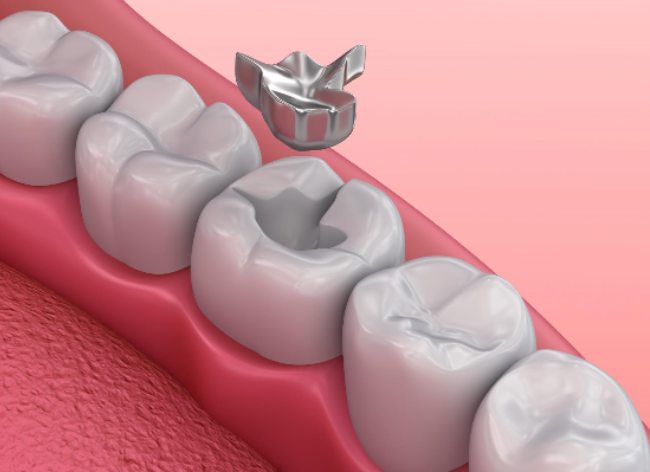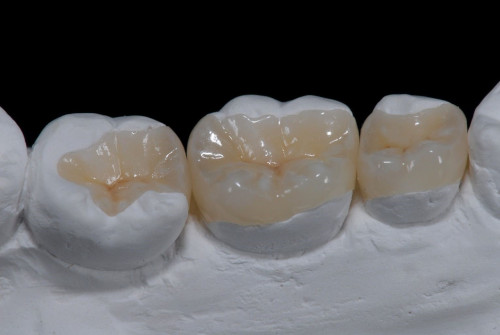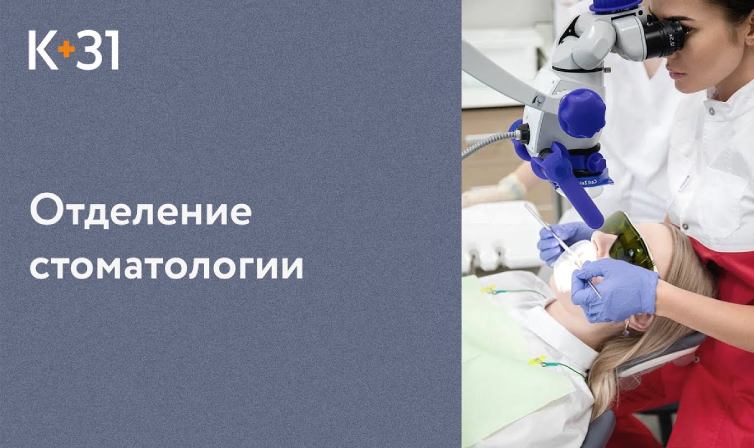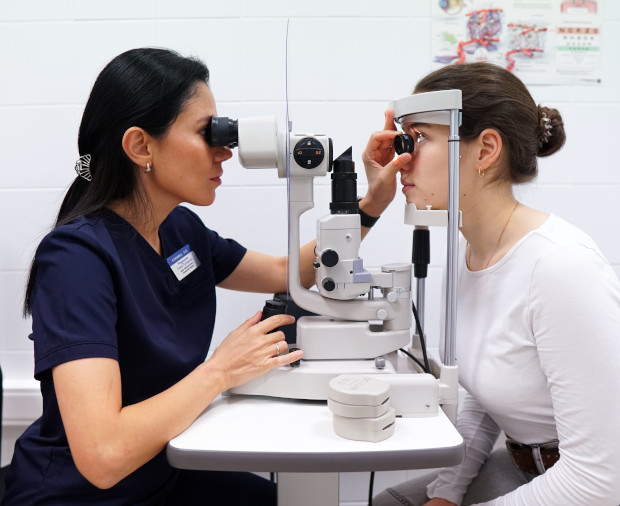Inlays for teeth

specialists

equipment

treatment

Indications for installing dental inlays
- Damage to hard tooth tissue exceeds 30%
- High abrasion of molars. Tabs help restore their original form and function
- Preparation for the installation of bridges. Inlays are often used to strengthen teeth that will serve as support for bridges
- Large carious cavities. If the cavity in the tooth is large enough, an inlay is a more effective solution compared to traditional filling
- Damage to hard tooth tissues. Enamel hypoplasia leads to significant destruction of the chewing element. Tabs solve this problem
- In addition, inserts help restore the worn chewing surface of the tooth and improve its functionality
Contraindications for installing dental inlays

Inlays are rarely used to treat incisors and canines because these teeth are subject to less chewing stress. Additional contraindications:
- Extensive tooth damage. In cases where the chewing element is severely damaged, other methods of restoring it (for example, crowns) become relevant
- Complex anatomical structure of the tooth. Installation of the inlay is difficult with steep bevels of the chewing element
- Bruxism. Teeth grinding leads to rapid wear of the liner
- Deep caries. If the pathological process has reached the dentin (the deep part of the tooth), the inlay is ineffective. This is due to the fact that with such penetration of caries, the tooth structure is already significantly weakened. For reliable fixation and operation of the liner, a sufficiently strong base is required
Dentists also do not recommend installing inserts on wisdom teeth (“eights”), as this is a technically difficult task.
What are dental inlays?
In most cases, metal inserts for teeth are used. They are made from alloys of gold, chromium and cobalt and are strong and durable.
There are also composite inlays on the market. They are created by polymerizing materials under the influence of light and heat. Such liners are easy to adjust, but their service life is shorter than that of metal and zirconium options.

There are also tabs:
- Ceramic They look like real teeth. Their main disadvantage is their lower strength compared to metal structures
- Zirconium Manufactured using digital modeling and milling. Zirconium liners are durable and aesthetically pleasing
How to install
Installation of dental inserts is a complex process that requires high qualifications and precision from the dentist. The procedure includes:
- Diagnostics. Before installing inlays on the teeth, the patient undergoes an X-ray or computed tomography scan. This allows the doctor to accurately assess the condition of the tooth and surrounding tissues
- Dissection. This stage involves removing damaged areas of the chewing element and identifying hidden pathologies
- Taking an impression. Based on it, the material and color of the future insert are selected
- 3D scanning. During the procedure, the specialist creates an accurate digital model of the tooth. This ensures a perfect fit of the insert
- Making the liner. The process of creating a microprosthesis takes from 7 to 10 days
- Installation. The finished inlay is fixed with special cement
After this, the specialist gives advice on caring for the insert and nutrition. In particular, after installing a dental inlay, it is necessary to follow the general rules of oral hygiene. It is important to brush your teeth regularly and thoroughly and use specialized toothpastes that provide increased protection. In addition, the use of dental floss and antiseptic rinses is recommended to prevent plaque formation.
The service life of a dental inlay depends on the material from which it is made. A metal liner lasts up to 20 years, a ceramic liner lasts 15 years, and a composite liner lasts no more than 5 years.


Modern methods of diagnostics and dental treatment at "K+31"
Our doctors

This award is given to clinics with the highest ratings according to user ratings, a large number of requests from this site, and in the absence of critical violations.

This award is given to clinics with the highest ratings according to user ratings. It means that the place is known, loved, and definitely worth visiting.

The ProDoctors portal collected 500 thousand reviews, compiled a rating of doctors based on them and awarded the best. We are proud that our doctors are among those awarded.
Make an appointment at a convenient time on the nearest date
Price
Other Services















































Advantages and disadvantages
The main advantages of restorative inlays for teeth are their durability and aesthetic appeal. In addition, their use minimizes the risk of damage to the chewing elements.
It is important to remember that if the inlay is installed incorrectly or does not match the size of the chewing element, various complications arise. Secondary caries, for example, develops in cases where the inlay does not fit tightly to the walls of the tooth (against this background, conditions are created for the accumulation of food debris and the proliferation of bacteria). If left untreated, additional destruction of dental tissue occurs.
Another common complication is pulpitis. It develops when the inlay puts excessive pressure on the pulp. The disease also progresses if the dental tissue was damaged during the installation process.